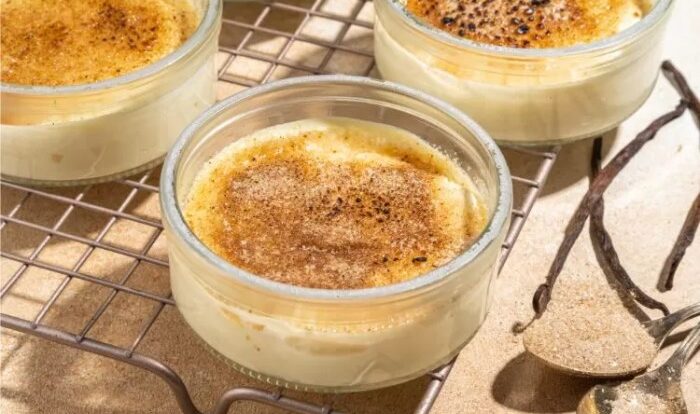
Crab brulee recipe – Welcome to the tantalizing world of crab brulee, a dish that tantalizes taste buds and sparks culinary curiosity. Dive into this delectable journey as we explore the history, ingredients, preparation, and sensory experience of this exquisite creation.
Prepare to be captivated as we unveil the secrets behind this culinary masterpiece, providing step-by-step guidance to help you recreate this dish in your own kitchen.
Culinary History and Origins of Crab Brulee
Crab brulee is a dish that has its origins in France. The earliest known recipe for crab brulee dates back to the 18th century, and it is believed to have been created by a chef named Marie-Antoine Carême. Carême was a renowned chef who is credited with developing many of the classic dishes of French cuisine, and his recipe for crab brulee is no exception.The
dish quickly became popular in France, and it soon spread to other parts of Europe. By the 19th century, crab brulee was being served in restaurants and homes all over the world. Today, it is considered a classic dish of French cuisine, and it is still enjoyed by people all over the world.Over
time, the recipe for crab brulee has evolved, and there are now many different variations of the dish. Some recipes call for using fresh crab meat, while others use canned crab meat. Some recipes add other ingredients to the dish, such as vegetables, cheese, or herbs.
No matter what the variation, crab brulee is always a delicious and satisfying dish.
For a more in-depth guide to preparing this delectable delicacy, check out the chicken of the woods recipe from Natrona County Extension. This recipe includes detailed instructions on cleaning, preparing, and cooking this flavorful fungus. Whether you’re a seasoned mushroom hunter or a curious culinary explorer, this recipe is sure to inspire you.
Geographical Origins, Crab brulee recipe
Crab brulee is a dish that originated in France. It is believed to have been created in the 18th century by a chef named Marie-Antoine Carême. The dish quickly became popular in France, and it soon spread to other parts of Europe.
By the 19th century, crab brulee was being served in restaurants and homes all over the world. Today, it is considered a classic dish of French cuisine, and it is still enjoyed by people all over the world.
Cultural Significance
Crab brulee is a dish that has a long and rich history. It is a dish that is enjoyed by people all over the world, and it is considered a classic of French cuisine. Crab brulee is a dish that is often served at special occasions, and it is a dish that is sure to impress your guests.
Ingredients and Preparation Techniques
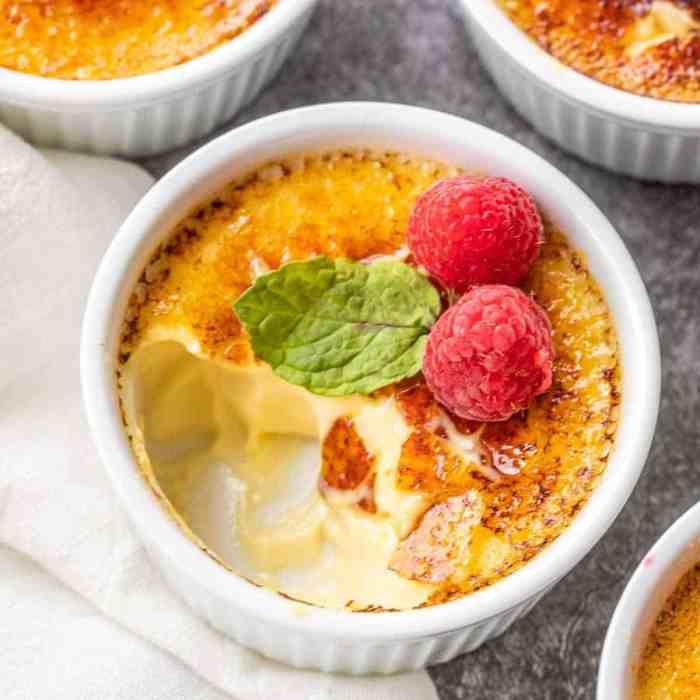
Crab brulee combines fresh crabmeat, creamy custard, and a crispy Parmesan crust for a decadent and flavorful dish. Here’s a detailed breakdown of the ingredients and step-by-step instructions for preparing this exquisite culinary creation:
Ingredients
To prepare crab brulee, you’ll need the following ingredients:
- Fresh crabmeat:1 pound, picked and flaked
- Heavy cream:1 cup, for the custard
- Eggs:3 large, for the custard
- Dijon mustard:1 tablespoon, for flavor
- Salt and pepper:To taste
- Parmesan cheese:1/2 cup, grated, for the crust
- Panko breadcrumbs:1/2 cup, for the crust
Preparation Techniques
Follow these steps to prepare crab brulee:
- Preheat oven:Preheat your oven to 350°F (175°C).
- Prepare ramekins:Grease four 6-ounce ramekins with butter or cooking spray.
- Make the custard:In a medium bowl, whisk together the heavy cream, eggs, Dijon mustard, salt, and pepper.
- Combine crab and custard:Fold the flaked crabmeat into the custard mixture.
- Fill ramekins:Divide the crab custard mixture evenly among the prepared ramekins.
- Make the crust:In a small bowl, combine the Parmesan cheese and panko breadcrumbs.
- Top with crust:Sprinkle the Parmesan-breadcrumb mixture evenly over the filled ramekins.
- Bake:Place the ramekins in a baking dish and add hot water to the dish, reaching halfway up the sides of the ramekins. Bake for 25-30 minutes, or until the custards are set and the crust is golden brown.
- Rest and serve:Let the crab brulees rest for a few minutes before serving.
- For the smoothest custard, use fresh, high-quality crabmeat and strain the custard mixture through a fine-mesh sieve before pouring it into the ramekins.
- To achieve a crispy crust, make sure the Parmesan-breadcrumb mixture is evenly distributed over the ramekins and press it down gently.
- Don’t overbake the crab brulees, as the custards will become rubbery. Check for doneness by inserting a toothpick into the center; it should come out clean.
- Serve the crab brulees immediately, garnished with fresh herbs or a dollop of sour cream.
- Dishes:Crab brulee pairs well with light and fresh dishes, such as a crisp green salad or a grilled fish fillet. The delicate flavors of the crab brulee will not overpower the other elements of the meal.
- Beverages:A crisp white wine, such as a Sauvignon Blanc or Pinot Grigio, complements the seafood flavors of crab brulee. For a more indulgent experience, try pairing it with a sparkling wine or a light-bodied red wine, such as a Pinot Noir.
- Condiments:A squeeze of lemon juice or a dollop of crème fraîche can add a touch of brightness and acidity to the dish, enhancing the overall flavor profile.
- Wine:A dry Riesling or a crisp Chardonnay can complement the sweetness of the custard and the briny notes of the crab. A full-bodied white wine, such as an oaked Chardonnay or a Viognier, can stand up to the richness of the dish.
- Cocktails:A classic martini, with its combination of gin and vermouth, provides a refreshing contrast to the richness of crab brulee. A champagne cocktail, with its effervescence and subtle sweetness, is another excellent choice.
- Reduced risk of heart disease due to the presence of omega-3 fatty acids
- Improved brain health and cognitive function supported by vitamin B12
- Boosted immune function attributed to the high selenium content
Tips for Perfect Texture and Flavor
Presentation and Variations: Crab Brulee Recipe
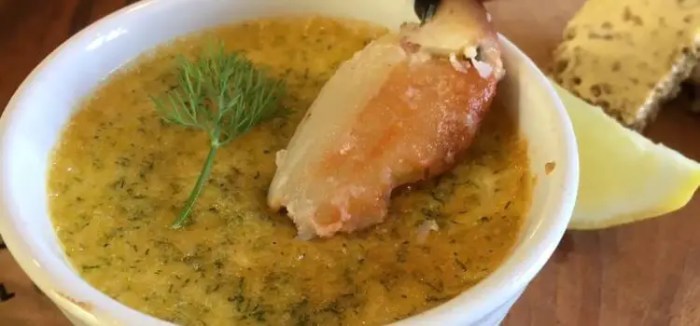
Traditionally, crab brulee is presented in individual ramekins, showcasing its golden-brown crust and creamy interior. However, creative variations can elevate the dish’s visual appeal.
Garnishes such as fresh herbs (chives, parsley), lemon zest, or crispy shallots add a touch of color and flavor. Accompaniments like grilled asparagus, roasted tomatoes, or a simple salad complement the richness of the brulee.
Modern Techniques and Flavor Combinations
Modern culinary techniques offer endless possibilities for innovative crab brulee variations. Sous vide cooking ensures a perfectly tender and evenly cooked crab filling. Molecular gastronomy techniques, like spherification, can create unique textures and flavor bursts.
Experimenting with flavor combinations can also lead to exciting creations. Adding a hint of smoked paprika or truffle oil infuses the brulee with a savory depth. Mixing in sautéed mushrooms or caramelized onions adds texture and umami.
Sensory Experience and Pairing Suggestions

Crab brulee offers a symphony of textures and flavors that dance upon the palate. The velvety smooth custard contrasts with the delicate crunch of the caramelized sugar crust, creating a harmonious balance that lingers in the mouth.
The flavor profile is a harmonious blend of sweet and savory, with the natural sweetness of the crab enhanced by the richness of the custard. The delicate hint of smoke from the caramelization adds an intriguing depth, while the subtle tang of the seafood provides a refreshing counterpoint.
The aroma of crab brulee is equally captivating, with the sweet notes of custard intertwining with the briny essence of the crab and the smoky fragrance of the caramelized sugar. This tantalizing scent draws diners in and heightens the anticipation for the culinary experience to come.
Complementary Pairings
To elevate the dining experience, consider pairing crab brulee with complementary dishes, beverages, and condiments.
Wine and Cocktail Pairings
For a truly memorable culinary journey, consider pairing crab brulee with specific wines or cocktails that create a harmonious balance of flavors.
Health Benefits and Nutritional Value
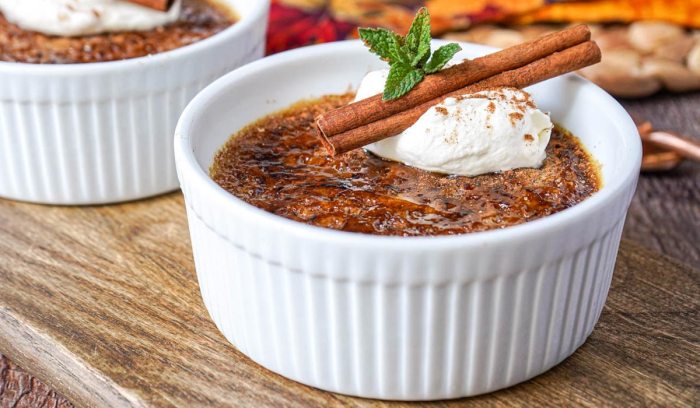
Crab brulee, like other seafood dishes, offers a range of nutritional benefits. It is a rich source of protein, providing essential amino acids necessary for muscle growth and repair.
Crab is also an excellent source of vitamins and minerals. It is high in vitamin B12, which supports red blood cell production and nervous system function. Additionally, crab contains significant amounts of selenium, zinc, and omega-3 fatty acids, all of which contribute to overall health and well-being.
If you’re looking for a unique and delicious way to enjoy the bounty of the forest, consider trying a chicken of the woods recipe . This mushroom, with its bright orange hue and meaty texture, has a flavor that’s surprisingly reminiscent of chicken.
Whether you sauté it, grill it, or roast it, this wild mushroom is sure to impress.
Potential Health Benefits
Consuming crab and other seafood has been associated with various potential health benefits, including:
Responsible Consumption
While crab brulee offers nutritional value, it is important to consume it in moderation as part of a balanced diet. Excessive consumption of crab can lead to high cholesterol levels due to its saturated fat content. Additionally, some individuals may be allergic to shellfish, including crab.
Recommended portion sizes for crab vary depending on factors such as age, activity level, and overall health. As a general guideline, a 3-ounce serving of cooked crab is considered a moderate portion.
Outcome Summary
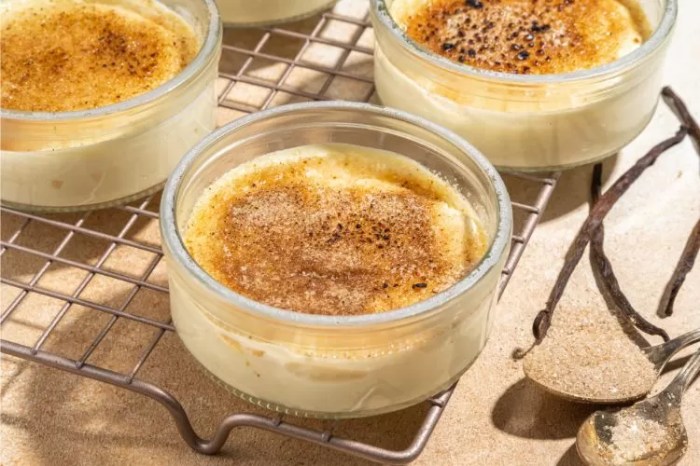
Our exploration of crab brulee concludes with a symphony of flavors and textures, leaving a lasting impression on your palate. Experiment with modern culinary techniques and flavor combinations to create your own unique variations, and don’t forget to pair it with the perfect wine or cocktail for an unforgettable dining experience.
Remember, cooking should be an adventure, so don’t be afraid to let your creativity shine through in your crab brulee creations.
Essential FAQs
What is the key to achieving the perfect texture in crab brulee?
Patience and precise temperature control are crucial. Cook the custard slowly and carefully to prevent curdling or overcooking.
Can I substitute other seafood for crab in this recipe?
Yes, you can use lobster, shrimp, or scallops as alternatives, adjusting the cooking time accordingly.
How can I enhance the presentation of my crab brulee?
Garnish with fresh herbs, such as chives or dill, and serve with a drizzle of olive oil or a dollop of crème fraîche.